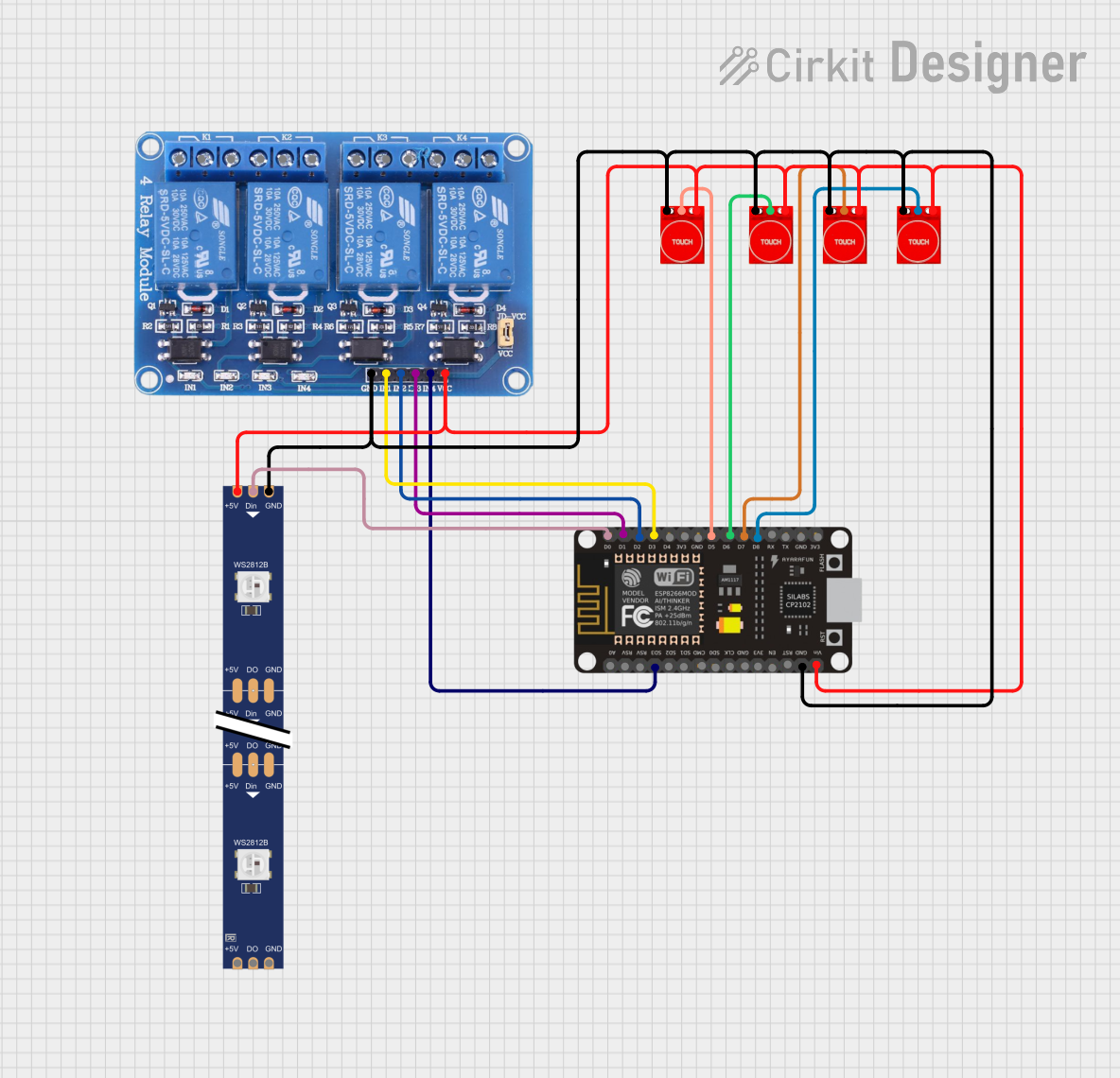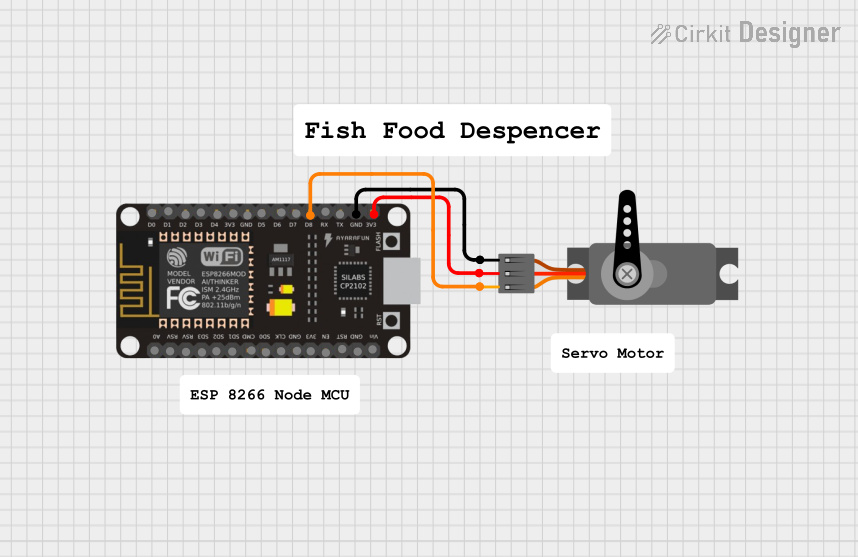
How to Use ESP8266: Examples, Pinouts, and Specs

 Design with ESP8266 in Cirkit Designer
Design with ESP8266 in Cirkit DesignerIntroduction
The ESP8266 is a low-cost Wi-Fi microchip with a full TCP/IP stack and microcontroller capability. It is widely used in Internet of Things (IoT) applications due to its affordability, ease of use, and robust feature set. The ESP8266 can operate as both a standalone microcontroller or as a Wi-Fi module for other microcontrollers, making it a versatile choice for a variety of projects.
Explore Projects Built with ESP8266

 Open Project in Cirkit Designer
Open Project in Cirkit Designer
 Open Project in Cirkit Designer
Open Project in Cirkit Designer
 Open Project in Cirkit Designer
Open Project in Cirkit Designer
 Open Project in Cirkit Designer
Open Project in Cirkit DesignerExplore Projects Built with ESP8266

 Open Project in Cirkit Designer
Open Project in Cirkit Designer
 Open Project in Cirkit Designer
Open Project in Cirkit Designer
 Open Project in Cirkit Designer
Open Project in Cirkit Designer
 Open Project in Cirkit Designer
Open Project in Cirkit DesignerCommon Applications and Use Cases
- Home automation systems
- Wireless sensor networks
- Smart appliances
- IoT prototyping and development
- Remote data logging and monitoring
- Wi-Fi-enabled robotics
Technical Specifications
The ESP8266 is available in various module formats, with the ESP-01 being one of the most popular. Below are the key technical specifications for the ESP8266:
Key Technical Details
- Operating Voltage: 3.0V to 3.6V (3.3V recommended)
- Current Consumption:
- Idle: ~70mA
- Peak (Wi-Fi transmission): ~200mA
- Processor: 32-bit Tensilica L106 running at 80MHz (can be overclocked to 160MHz)
- Flash Memory: 512KB to 4MB (depending on the module)
- Wi-Fi Standards: 802.11 b/g/n
- GPIO Pins: Up to 17 (depending on the module)
- Communication Protocols: UART, SPI, I2C, PWM, ADC
- Operating Temperature: -40°C to 125°C
Pin Configuration and Descriptions
Below is the pinout for the ESP-01 module, one of the most commonly used ESP8266 variants:
| Pin | Name | Description |
|---|---|---|
| 1 | VCC | Power input (3.3V). Do not exceed 3.6V. |
| 2 | GND | Ground connection. |
| 3 | TX | UART Transmit pin. Used for serial communication. |
| 4 | RX | UART Receive pin. Used for serial communication. |
| 5 | CH_PD | Chip enable. Must be pulled high (3.3V) to enable the module. |
| 6 | GPIO0 | General-purpose I/O pin. Used for boot mode selection during startup. |
| 7 | GPIO2 | General-purpose I/O pin. |
| 8 | RST | Reset pin. Pull low to reset the module. |
Usage Instructions
The ESP8266 can be used as a standalone microcontroller or as a Wi-Fi module for other microcontrollers like the Arduino UNO. Below are the steps to use the ESP8266 in a circuit:
Connecting the ESP8266 to an Arduino UNO
- Power Supply: The ESP8266 operates at 3.3V. Use a voltage regulator or level shifter to step down the Arduino's 5V output to 3.3V.
- Wiring:
- Connect the ESP8266's
VCCandCH_PDpins to 3.3V. - Connect
GNDto ground. - Connect the
TXpin of the ESP8266 to theRXpin of the Arduino (via a voltage divider to step down the 5V signal). - Connect the
RXpin of the ESP8266 to theTXpin of the Arduino.
- Connect the ESP8266's
- Boot Mode: To upload code, pull
GPIO0low (connect to GND). For normal operation, leave it high.
Example Code for Arduino UNO
The following example demonstrates how to connect the ESP8266 to a Wi-Fi network using the Arduino IDE:
#include <SoftwareSerial.h>
// Define RX and TX pins for SoftwareSerial
SoftwareSerial esp8266(2, 3); // RX = Pin 2, TX = Pin 3
void setup() {
Serial.begin(9600); // Start Serial Monitor communication
esp8266.begin(9600); // Start ESP8266 communication
Serial.println("Connecting to Wi-Fi...");
// Send AT commands to connect to Wi-Fi
esp8266.println("AT+CWJAP=\"YourSSID\",\"YourPassword\"");
delay(5000); // Wait for the connection to establish
// Check connection status
esp8266.println("AT+CIFSR"); // Get IP address
}
void loop() {
// Forward data between Serial Monitor and ESP8266
if (esp8266.available()) {
Serial.write(esp8266.read());
}
if (Serial.available()) {
esp8266.write(Serial.read());
}
}
Note: Replace YourSSID and YourPassword with your Wi-Fi network credentials.
Important Considerations and Best Practices
- Always use a 3.3V power supply for the ESP8266. Exceeding this voltage can damage the module.
- Use a level shifter or voltage divider for communication with 5V microcontrollers.
- Ensure proper decoupling capacitors are used to stabilize the power supply.
- Avoid long wires for the antenna to maintain good Wi-Fi signal strength.
Troubleshooting and FAQs
Common Issues and Solutions
ESP8266 Not Responding to AT Commands:
- Ensure the
CH_PDpin is pulled high (connected to 3.3V). - Check the baud rate. Some modules use 115200 by default; adjust the Serial Monitor settings accordingly.
- Ensure the
Wi-Fi Connection Fails:
- Double-check the SSID and password.
- Ensure the router is within range and supports 2.4GHz Wi-Fi (ESP8266 does not support 5GHz).
Module Overheating:
- Verify the power supply voltage is within the recommended range (3.0V to 3.6V).
- Use a heat sink or improve ventilation if necessary.
Frequent Resets or Instability:
- Add a 10µF capacitor between
VCCandGNDto stabilize the power supply. - Check for loose connections or poor soldering.
- Add a 10µF capacitor between
FAQs
Q: Can the ESP8266 be programmed directly without an Arduino?
A: Yes, the ESP8266 can be programmed directly using the Arduino IDE or other tools like NodeMCU firmware. You will need a USB-to-Serial adapter for this.
Q: What is the maximum range of the ESP8266 Wi-Fi?
A: The range depends on the environment but is typically around 50 meters indoors and up to 100 meters outdoors.
Q: Can the ESP8266 handle HTTPS requests?
A: Yes, but it requires additional memory and proper firmware support. Using libraries like WiFiClientSecure can simplify this process.
Q: Is the ESP8266 compatible with 5GHz Wi-Fi networks?
A: No, the ESP8266 only supports 2.4GHz Wi-Fi networks.